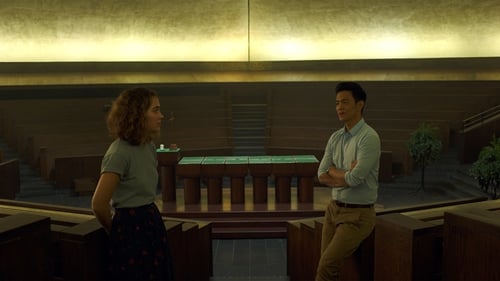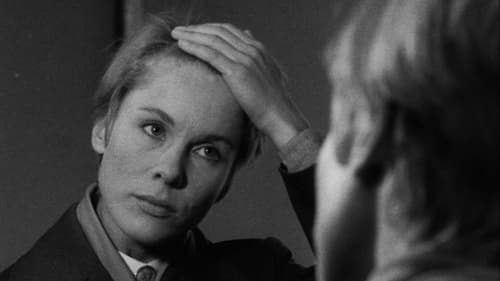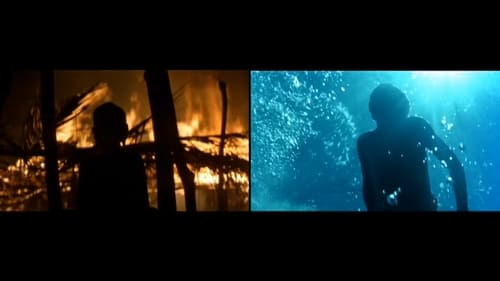Kogonada
Nascimento : , Seoul, South Korea
História
Kogonada is a South Korean-born American filmmaker known for his feature films Columbus and After Yang, as well as his video essays: short videos which analyze the content, form, and structure of films and television series generally through narration and editing. His video essays often highlight a particular aesthetic used by film directors.

Writer
Num futuro próximo, uma família enfrenta questões de amor, ligação e perda após o seu ajudante ter sofrido problemas inesperados.

Editor
Num futuro próximo, uma família enfrenta questões de amor, ligação e perda após o seu ajudante ter sofrido problemas inesperados.

Director
Num futuro próximo, uma família enfrenta questões de amor, ligação e perda após o seu ajudante ter sofrido problemas inesperados.

Director
Kogonada looks at how the motif of doors reverberates through Robert Bresson's work.

Writer
Casey (Haley Lu Richardson) vive com sua mãe em uma cidade pouco conhecida e assombrada pela promessa de modernismo. Jin (John Cho), um visitante do outro lado do mundo, visita seu pai que está quase falecendo. Sobrecarregados pelo peso do futuro, eles encontram refúgio um no outro e na arquitetura que os rodeia.

Editor
Casey (Haley Lu Richardson) vive com sua mãe em uma cidade pouco conhecida e assombrada pela promessa de modernismo. Jin (John Cho), um visitante do outro lado do mundo, visita seu pai que está quase falecendo. Sobrecarregados pelo peso do futuro, eles encontram refúgio um no outro e na arquitetura que os rodeia.

Director
Casey (Haley Lu Richardson) vive com sua mãe em uma cidade pouco conhecida e assombrada pela promessa de modernismo. Jin (John Cho), um visitante do outro lado do mundo, visita seu pai que está quase falecendo. Sobrecarregados pelo peso do futuro, eles encontram refúgio um no outro e na arquitetura que os rodeia.

Director
Kogonada’s video essay showcases the similarities of the multiple films Yasujiro Ozu made in his lifetime. Ozu created a genre of his own – a way of filmmaking that was cultivated and nourished throughout Ozu’s career as a filmmaker.

Director
In the 1960s, pioneering French New Wave filmmaker Jean-Luc Godard introduced the world to a new cinematic lexicon, generated from his innovative, auteurist style. Between 1960 and 1967 alone, he made fifteen features (beginning with his groundbreaking début, Breathless)—and it’s this period that regular Criterion Collection contributor Kogonada explores in a new video essay highlighting the iconic director’s signature themes and devices.

Editor
This new video essay by filmmaker Kogonada explores the many layers of director Francois Truffaut's masterpiece "Day for Night."

Writer
This new video essay by filmmaker Kogonada explores the many layers of director Francois Truffaut's masterpiece "Day for Night."

Director
This new video essay by filmmaker Kogonada explores the many layers of director Francois Truffaut's masterpiece "Day for Night."

Narrator
This new video essay by filmmaker Kogonada explores the many layers of director Francois Truffaut's masterpiece "Day for Night."

Director
Vídeo feito por Kogonada para a Criterion Collection sobre a restauração da Trilogia de Apu de Satyajit Ray.

Editor
40,000 years in the making: Kogonada's video essay created for The Connected Series.

Director
40,000 years in the making: Kogonada's video essay created for The Connected Series.

Editor
Filmmaker ::kogonada explores director Ingmar Bergman’s “Cries and Whispers," a film in three movements.

Writer
Filmmaker ::kogonada explores director Ingmar Bergman’s “Cries and Whispers," a film in three movements.

Narrator
Filmmaker ::kogonada explores director Ingmar Bergman’s “Cries and Whispers," a film in three movements.

Director
Filmmaker ::kogonada explores director Ingmar Bergman’s “Cries and Whispers," a film in three movements.

Editor
Filmmaker Kogonada reflects on women and mirrors in the films of Ingmar Bergman.

Director
Filmmaker Kogonada reflects on women and mirrors in the films of Ingmar Bergman.

Editor
A video essay on how Andrei Tarkovsky’s Solaris transcends science fiction.

Director
A video essay on how Andrei Tarkovsky’s Solaris transcends science fiction.

Director
Kogonada's video essay made in conjunction with the release of Criterion Designs, a 300-page book, which features highlights from cover art commissioned by the Criterion Collection, including never-before-seen sketches and concept art.

Director
"I wanted to write a fantasy with the atomic bomb as the theme." – Nobuhiko Obayashi

Editor
A visual essay for "La dolce vita," directed by Kogonada for the Criterion Collection.

Director
A visual essay for "La dolce vita," directed by Kogonada for the Criterion Collection.

Editor
When characters stare at the camera in the films of Alfred Hitchcock, the look is almost always associated with the threat of death (through the eyes of a victim, a murderer, a witness). This momentary suspension between death and life is partly what makes Hitchcock the indisputable master of suspense.

Director
When characters stare at the camera in the films of Alfred Hitchcock, the look is almost always associated with the threat of death (through the eyes of a victim, a murderer, a witness). This momentary suspension between death and life is partly what makes Hitchcock the indisputable master of suspense.

Director
A visual essay on the tactile world of Robert Bresson created for the Criterion Collection.

Editor
Vídeo-ensaio sobre a simetria de planos nos filmes de Wes Anderson.

Director
Vídeo-ensaio sobre a simetria de planos nos filmes de Wes Anderson.

Director
If cinema is the art of time, Linklater is one of its most thoughtful and engaged directors. Unlike other filmmakers identified as auteurs, Linklater’s distinction is not found on the surface of his films, in a visual style or signature shot, but rather in their DNA, as ongoing conversations with cinema, which is to say, with time itself. A visual essay produced by Sight and Sound.

Director
Filmmaker Kogonada unpicks what defines the Golden Age of Italian cinema with a side-by-side comparison of two edits of the same film, one according to Italian director Vittorio De Sica, and the other according to Hollywood producer David O. Selznick.

Editor
Of all the recurring signatures of Malick, his use of fire and water might be the most telling, in part because there’s a significant shift between early Malick (Badlands & Days of Heaven) and later Malick (The Thin Red Line, The New World, The Tree of Life & To the Wonder). Early Malick favors fire. Later Malick favors water. In To the Wonder, Malick forgoes fire altogether for the first time in his career. Water reigns.

Director
Of all the recurring signatures of Malick, his use of fire and water might be the most telling, in part because there’s a significant shift between early Malick (Badlands & Days of Heaven) and later Malick (The Thin Red Line, The New World, The Tree of Life & To the Wonder). Early Malick favors fire. Later Malick favors water. In To the Wonder, Malick forgoes fire altogether for the first time in his career. Water reigns.

Editor
The cinema of Koreeda Hirokazu is defined by moments of everyday life. Whatever potential there is for heightened drama – the suicide of a husband, a cult massacre, abandoned children – it is diffused by the familiar rhythms of everydayness. This attention to the everyday must be understood within the context of death, which plays a significant role in all of Koreeda’s films. It is death that deepens our sense of life and makes even the most mundane moment seem profound.

Director
The cinema of Koreeda Hirokazu is defined by moments of everyday life. Whatever potential there is for heightened drama – the suicide of a husband, a cult massacre, abandoned children – it is diffused by the familiar rhythms of everydayness. This attention to the everyday must be understood within the context of death, which plays a significant role in all of Koreeda’s films. It is death that deepens our sense of life and makes even the most mundane moment seem profound.

Director

Director
Video Essay on King of the Hill

Editor
Nos filmes do cineasta japonês Yasujirō Ozu (1903-63), as pessoas aparecem constantemente andando pelos corredores. Sua arte reside nos espaços intermediários da vida moderna, no transitório: as vielas não são mais escuras, armadilhas ameaçadoras onde nasce o suspense, mas simplesmente lugares de passagem.

Director
Nos filmes do cineasta japonês Yasujirō Ozu (1903-63), as pessoas aparecem constantemente andando pelos corredores. Sua arte reside nos espaços intermediários da vida moderna, no transitório: as vielas não são mais escuras, armadilhas ameaçadoras onde nasce o suspense, mas simplesmente lugares de passagem.

Director
Kogonada's visual essay about the formalistice choices of master filmmaker Stanley Kubrick

Director
Sound in film is often complimentary. Rarely does it suggest an aesthetic of its own. The punctuating, rhythmic soundscapes of Aronofsky are the exception. They stay with you long after the film.

Director
Tarantino // From Below
Music: Kaifuku Suru Kizu by Salyu

Editor
A visual essay that highlights top-down shots from Wes Anderson's filmography.

Director
A visual essay that highlights top-down shots from Wes Anderson's filmography.






















